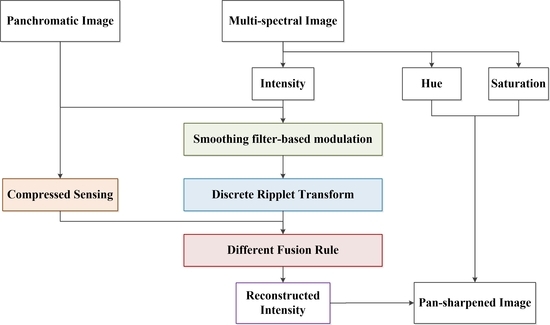An IHS-Based Pan-Sharpening Method for Spectral Fidelity Improvement Using Ripplet Transform and Compressed Sensing
Abstract
1. Introduction
2. Related Work
2.1. IHS Transform and Spectral Distortion
2.2. Discrete Ripplet Transform (DRT)
2.3. Compressed Sensing and Sparse Representation
3. Proposed Method
3.1. Spectral Fidelity Improvement of Intensity Component Using Sfim
3.2. Intensity Component Reconstruction Using DRT and Compressed Sensing
3.2.1. High-Frequency Sub-Images Fusion
3.2.2. Low-Frequency Sub-Images Fusion
3.3. The Over-All Pan-Sharpening Method
- Data pre-processing: The MS and PAN images are co-registered precisely at first. In the meantime, the MS image is up-sampled into the same pixel size and spatial scale as PAN image using cubic convolution. This step ensures the MS and PAN images have the same pixel size and geographic coordinates.
- IHS transform: The MS image is converted into IHS space to obtain the component according to Equation (2). The histogram of the component and of the PAN image are matched.
- SFIM processing: SFIM is performed on the component and the PAN image based on Equation (15) to obtain . In SFIM, the smoothing filter size should be defined experimentally.
- DRT decomposition: The new intensity component () and the PAN image are decomposed using two-level DRT with and . The high frequency sub-images (, ) and low frequency sub-images (, ) are generated by performing DRT.
- High-frequency sub-images fusion: and are fused to obtain according to the local variance algorithm in Section 3.2.1.
- Low-frequency sub-images fusion: Compressed sensing and the local weighted algorithm discussed in Section 3.2.2 is performed on and to obtain .
- IDRT transform: IDRT is performed on and to obtain the reconstructed intensity component () following Equation (9).
- Inverse IHS transform: By inverse IHS transform, we transform the reconstructed intensity component () and original component and component back into multi-band spaces to obtain the pan-sharpened image.
4. Results and Discussion
4.1. Qualitative Comparison
4.2. Quantitative Comparison
4.3. Discussion on Independence Factors and Contributions
4.3.1. Discussion on Averaging Filer Kernel Size in SFIM
4.3.2. Dependence on Image Patch Size and Overlapping Ratio
- The increase of the overlapping ratio is beneficial to performance but leads to large increases in computation time.
- For WorldView-2, Pleiades-1A, and Triplesat data, is the optimal image patch size.
- In our experiments, is the most desirable value to balance performance and computation time.
4.3.3. Contributions
5. Conclusions
Author Contributions
Funding
Acknowledgments
Conflicts of Interest
References
- Ghassemian, H. A review of remote sensing image fusion methods. Inf. Fusion 2016, 32, 75–89. [Google Scholar] [CrossRef]
- Otazu, X.; Gonzalez-Audicana, M.; Fors, O.; Nunez, J. Introduction of sensor spectral response into image fusion methods. Application to wavelet-based methods. IEEE Trans. Geosci. Remote Sens. 2005, 43, 2376–2385. [Google Scholar] [CrossRef]
- Pohl, C.; Van Genderen, J.L. Review article Multisensor image fusion in remote sensing: Concepts, methods and applications. Int. J. Remote Sens. 1998, 19, 823–854. [Google Scholar] [CrossRef]
- Simone, G.; Farina, A.; Morabito, F.C.; Serpico, S.B.; Bruzzone, L. Image fusion techniques for remote sensing applications. Inf. Fusion 2002, 3, 3–15. [Google Scholar] [CrossRef]
- Melgani, F.; Bazi, Y. Markovian fusion approach to robust unsupervised change detection in remotely sensed imagery. IEEE Geosci. Remote Sens. Lett. 2006, 3, 457–461. [Google Scholar] [CrossRef]
- Alparone, L.; Aiazzi, B.; Baronti, S.; Garzelli, A. Remote Sensing Image Fusion; CRC Press: Boca Raton, FL, USA, 2015. [Google Scholar]
- Kavzoglu, T.; Tonbul, H. An experimental comparison of multi-resolution segmentation, SLIC and K-means clustering for object-based classification of VHR imagery. Int. J. Remote Sens. 2018, 1–17. [Google Scholar] [CrossRef]
- Ibarrola-Ulzurrun, E.; Gonzalo-Martin, C.; Marcello-Ruiz, J.; Garcia-Pedrero, A.; Rodriguez-Esparragon, D. Fusion of high resolution multispectral imagery in vulnerable coastal and land ecosystems. Sensors 2017, 17, 228. [Google Scholar] [CrossRef] [PubMed]
- Li, S.; Kang, X.; Fang, L.; Hu, J.; Yin, H. Pixel-level image fusion: A survey of the state of the art. Inf. Fusion 2017, 33, 100–112. [Google Scholar] [CrossRef]
- Garzelli, A.; Nencini, F.; Alparone, L.; Aiazzi, B.; Baronti, S. Pan-sharpening of multispectral images: A critical review and comparison. In Proceedings of the IGARSS 2004, IEEE International Geoscience and Remote Sensing Symposium, Anchorage, AK, USA, 20–24 September 2004. [Google Scholar]
- Thomas, C.; Ranchin, T.; Wald, L.; Chanussot, J. Synthesis of multispectral images to high spatial resolution: A critical review of fusion methods based on remote sensing physics. IEEE Trans. Geosci. Remote Sens. 2008, 46, 1301–1312. [Google Scholar] [CrossRef]
- Tu, T.-M.; Su, S.-C.; Shyu, H.-C.; Huang, P.S. A new look at IHS-like image fusion methods. Inf. Fusion 2001, 2, 177–186. [Google Scholar] [CrossRef]
- Rahmani, S.; Strait, M.; Merkurjev, D.; Moeller, M.; Wittman, T. An adaptive IHS pan-sharpening method. IEEE Geosci. Remote Sens. Lett. 2010, 7, 746–750. [Google Scholar] [CrossRef]
- Guo, Q.; Ehlers, M.; Wang, Q.; Pohl, C.; Hornberg, S.; Li, A. Ehlers pan-sharpening performance enhancement using HCS transform for n-band data sets. Int. J. Remote Sens. 2017, 38, 4974–5002. [Google Scholar] [CrossRef]
- Laben, C.A.; Brower, B.V. Process for Enhancing the Spatial Resolution of Multispectral Imagery Using Pan-Sharpening. U.S. Patent US6011875A, 19 April 1998. [Google Scholar]
- Gonzalez-Audicana, M.; Saleta, J.L.; Catalan, R.G.; Garcia, R. Fusion of multispectral and panchromatic images using improved IHS and PCA mergers based on wavelet decomposition. IEEE Trans. Geosci. Remote Sens. 2004, 42, 1291–1299. [Google Scholar] [CrossRef]
- Faragallah, O.S. Enhancing multispectral imagery spatial resolution using optimized adaptive PCA and high-pass modulation. Int. J. Remote Sens. 2018, 1–15. [Google Scholar] [CrossRef]
- Nunez, J.; Otazu, X.; Fors, O.; Prades, A.; Pala, V.; Arbiol, R. Multiresolution-based image fusion with additive wavelet decomposition. IEEE Trans. Geosci. Remote Sens. 1999, 37, 1204–1211. [Google Scholar] [CrossRef]
- Pradhan, P.S.; King, R.L.; Younan, N.H.; Holcomb, D.W. Estimation of the number of decomposition levels for a wavelet-based multiresolution multisensor image fusion. IEEE Trans. Geosci. Remote Sens. 2006, 44, 3674–3686. [Google Scholar] [CrossRef]
- Shah, V.P.; Younan, N.H.; King, R.L. An efficient pan-sharpening method via a combined adaptive pca approach and contourlets. IEEE Trans. Geosci. Remote Sens. 2008, 46, 1323–1335. [Google Scholar] [CrossRef]
- Nencini, F.; Garzelli, A.; Baronti, S.; Alparone, L. Remote sensing image fusion using the curvelet transform. Inf. Fusion 2007, 8, 143–156. [Google Scholar] [CrossRef]
- Li, H.; Jing, L.; Tang, Y. Assessment of pansharpening methods applied to worldview-2 imagery fusion. Sensors 2017, 17, 89. [Google Scholar] [CrossRef] [PubMed]
- Ghahremani, M.; Ghassemian, H. Remote sensing image fusion using ripplet transform and compressed sensing. IEEE Geosci. Remote Sens. Lett. 2015, 12, 502–506. [Google Scholar] [CrossRef]
- Aiazzi, B.; Alparone, L.; Baronti, S.; Carlà, R.; Garzelli, A.; Santurri, L. Sensitivity of pansharpening methods to temporal and instrumental changes between multispectral and panchromatic data sets. IEEE Trans. Geosci. Remote Sens. 2017, 55, 308–319. [Google Scholar] [CrossRef]
- Meng, X.; Li, J.; Shen, H.; Zhang, L.; Zhang, H. Pansharpening with a guided filter based on three-layer decomposition. Sensors 2016, 16, 1068. [Google Scholar] [CrossRef] [PubMed]
- Li, S.; Yang, B. A new pan-sharpening method using a compressed sensing technique. IEEE Trans. Geosci. Remote Sens. 2011, 49, 738–746. [Google Scholar] [CrossRef]
- Ghahremani, M.; Ghassemian, H. A compressed-sensing-based pan-sharpening method for spectral distortion reduction. IEEE Trans. Geosci. Remote Sens. 2016, 54, 2194–2206. [Google Scholar] [CrossRef]
- Huang, B.; Song, H.; Cui, H.; Peng, J.; Xu, Z. Spatial and spectral image fusion using sparse matrix factorization. IEEE Trans. Geosci. Remote Sens. 2014, 52, 1693–1704. [Google Scholar] [CrossRef]
- Zhou, X.; Liu, J.; Liu, S.; Cao, L.; Zhou, Q.; Huang, H. A GIHS-based spectral preservation fusion method for remote sensing images using edge restored spectral modulation. ISPRS-J. Photogramm. Remote Sens. 2014, 88, 16–27. [Google Scholar] [CrossRef]
- Imani, M.; Ghassemian, H. Pansharpening optimisation using multiresolution analysis and sparse representation. Int. J. Image Data Fusion. 2017, 8, 270–292. [Google Scholar] [CrossRef]
- Li, S.; Yang, B.; Hu, J. Performance comparison of different multi-resolution transforms for image fusion. Inf. Fusion 2011, 12, 74–84. [Google Scholar] [CrossRef]
- Rehman, U.N.; Ehsan, S.; Abdullah, M.S.; Akhtar, J.M.; Mandic, P.D.; McDonald-Maier, D.K. Multi-scale pixel-based image fusion using multivariate empirical mode decomposition. Sensors 2015, 15, 10923–10947. [Google Scholar] [CrossRef] [PubMed]
- Eghbalian, S.; Ghassemian, H. Multi spectral image fusion by deep convolutional neural network and new spectral loss function. Int. J. Remote Sens. 2018, 39, 3983–4002. [Google Scholar] [CrossRef]
- Li, H.; Jing, L.; Tang, Y.; Ding, H. An improved pansharpening method for misaligned panchromatic and multispectral data. Sensors. 2018, 18, 557. [Google Scholar] [CrossRef] [PubMed]
- Zhang, L.; Zhang, J. A novel remote-sensing image fusion method based on hybrid visual saliency analysis. Int. J. Remote Sens. 2018, 1–23. [Google Scholar] [CrossRef]
- Matsuoka, M.; Tadono, T.; Yoshioka, H. Effects of the spectral properties of a panchromatic image on pan-sharpening simulated using hyperspectral data. Int. J. Image Data Fusion. 2016, 7, 339–359. [Google Scholar] [CrossRef]
- Li, Z.; Leung, H. Fusion of multispectral and panchromatic images using a restoration-based method. IEEE Trans. Geosci. Remote Sens. 2009, 47, 1482–1491. [Google Scholar] [CrossRef]
- Zhang, Q.; Liu, Y.; Blum, R.S.; Han, J.; Tao, D. Sparse representation based multi-sensor image fusion for multi-focus and multi-modality images: A review. Inf. Fusion 2018, 40, 57–75. [Google Scholar] [CrossRef]
- Olshausen, B.A.; Field, D.J. Emergence of simple-cell receptive field properties by learning a sparse code for natural images. Nature 1996, 381, 607. [Google Scholar] [CrossRef] [PubMed]
- Candes, E.; Romberg, J.; Tao, T. Stable Signal Recovery from Incomplete and Inaccurate Measurements. Mathematics. Commun. Pure Appl. Math. 2005, 1207–1223. [Google Scholar] [CrossRef]
- Lustig, M.; Donoho, D.L.; Santos, J.M.; Pauly, J.M. Compressed Sensing MRI. IEEE Signal Process. Mag. 2008, 25, 72–82. [Google Scholar] [CrossRef]
- Elad, M.; Aharon, M. Image denoising via sparse and redundant representations over learned dictionaries. IEEE Trans. Image Process. 2006, 15, 3736–3745. [Google Scholar] [CrossRef] [PubMed]
- Yang, B.; Li, S. Multifocus image fusion and restoration with sparse representation. IEEE Trans. Instrum. Meas. 2010, 59, 884–892. [Google Scholar] [CrossRef]
- Wang, J.; Peng, J.; Jiang, X.; Feng, X.; Zhou, J. Remote-sensing image fusion using sparse representation with sub-dictionaries. Int. J. Remote Sens. 2017, 38, 3564–3585. [Google Scholar] [CrossRef]
- Zhang, Y.; Hong, G. An IHS and wavelet integrated approach to improve pan-sharpening visual quality of natural colour IKONOS and QuickBird images. Inf. Fusion 2005, 6, 225–234. [Google Scholar] [CrossRef]
- Huang, Q.; Zhao, Z.; Gao, Q.; Meng, Y.; Ma, J.; Chen, J. improved fusion method for remote sensing imagery using NSCT and extend IHS. IFAC-PapersOnLine. 2015, 48, 64–69. [Google Scholar] [CrossRef]
- Cheng, J.; Liu, H.; Liu, T.; Wang, F.; Li, H. Remote sensing image fusion via wavelet transform and sparse representation. ISPRS-J. Photogramm. Remote Sens. 2015, 104, 158–173. [Google Scholar] [CrossRef]
- Xu, J.; Wu, D. Ripplet transform type II transform for feature extraction. IET Image Process. 2012, 6, 374–385. [Google Scholar] [CrossRef]
- Xu, J.; Yang, L.; Wu, D. Ripplet: A new transform for image processing. J. Vis. Commun. Image Represent. 2010, 21, 627–639. [Google Scholar] [CrossRef]
- Elad, M.; Aharon, M. Image denoising via learned dictionaries and sparse representation. In Proceedings of the 2006 IEEE Computer Society Conference on Computer Vision and Pattern Recognition (CVPR’06), New York, NY, USA, 17–22 June 2006; pp. 895–900. [Google Scholar]
- Liu, J.G. Smoothing filter-based intensity modulation: A spectral preserve image fusion technique for improving spatial details. Int. J. Remote Sens. 2000, 21, 3461–3472. [Google Scholar] [CrossRef]
- Garzelli, A.; Nencini, F. Fusion of panchromatic and multispectral images by genetic algorithms. In Proceedings of the 2006 IEEE International Symposium on Geoscience and Remote Sensing, Denver, CO, USA, 31 July–4 August 2006; pp. 3810–3813. [Google Scholar]
- Aiazzi, B.; Alparone, L.; Baronti, S.; Garzelli, A. Context-driven fusion of high spatial and spectral resolution images based on oversampled multiresolution analysis. IEEE Trans. Geosci. Remote Sens. 2002, 40, 2300–2312. [Google Scholar] [CrossRef]
- Aiazzi, B.; Alparone, L.; Baronti, S.; Garzelli, A.; Selva, M. MTF-tailored multiscale fusion of high-resolution MS and pan imagery. Photogramm. Eng. Remote Sens. 2015, 72, 591–596. [Google Scholar] [CrossRef]
- Starck, J.-L.; Candès, E.J.; Donoho, D.L. The curvelet transform for image denoising. IEEE Trans. Image Process. 2002, 11, 670–684. [Google Scholar] [CrossRef] [PubMed]
- Mairal, J.; Elad, M.; Sapiro, G. Sparse representation for color image restoration. IEEE Trans. Image Process. 2008, 17, 53–69. [Google Scholar] [CrossRef] [PubMed]
- Liu, Y.; Liu, S.; Wang, Z. A general framework for image fusion based on multi-scale transform and sparse representation. Inf. Fusion 2015, 24, 147–164. [Google Scholar] [CrossRef]
- Jiang, Y.; Wang, M. Image fusion with morphological component analysis. Inf. Fusion 2014, 18, 107–118. [Google Scholar] [CrossRef]
- Bruckstein, A.M.; Donoho, D.L.; Elad, M. From Sparse Solutions of Systems of Equations to Sparse Modeling of Signals and Images. SIAM Rev. 2009, 51, 34–81. [Google Scholar] [CrossRef]
- Woodcock, C.E.; Strahler, A.H. The factor of scale in remote sensing. Remote Sens. Environ. 1987, 21, 311–332. [Google Scholar] [CrossRef]
- Chu, H.; Zhu, W. Fusion of IKONOS satellite imagery using IHS transform and local variation. IEEE Geosci. Remote Sens. Lett. 2008, 5, 653–657. [Google Scholar] [CrossRef]
- Dong, Z.; Wang, Z.; Liu, D.; Zhang, B.; Zhao, P.; Tang, X.; Jia, M. SPOT5 multi-spectral (MS) and panchromatic (PAN) image fusion using an improved wavelet method based on local algorithm. Comput. Geosci. 2013, 60, 134–141. [Google Scholar] [CrossRef]
- Rubinstein, R.; Zibulevsky, M.; Elad, M. Double sparsity: Learning sparse dictionaries for sparse signal approximation. IEEE Trans. Signal Process. 2010, 58, 1553–1564. [Google Scholar] [CrossRef]
- Vicinanza, M.R.; Restaino, R.; Vivone, G.; Mura, M.D.; Chanussot, J. A pansharpening method based on the sparse representation of injected details. IEEE Geosci. Remote Sens. Lett. 2015, 12, 180–184. [Google Scholar] [CrossRef]
- Cost, S.; Salzberg, S. A weighted nearest neighbor algorithm for learning with symbolic features. Mach. Learn. 1993, 10, 57–78. [Google Scholar] [CrossRef]
- Liu, Y.; Wang, Z. A practical pan-sharpening method with wavelet transform and sparse representation. In Proceedings of the 2013 IEEE International Conference on Imaging Systems and Techniques (IST), Beijing, China, 22–23 October 2013; pp. 288–293. [Google Scholar]
- Ghahremani, M.; Ghassemian, H. Remote-sensing image fusion based on curvelets and ICA. Int. J. Remote Sens. 2015, 36, 4131–4143. [Google Scholar] [CrossRef]
- Alparone, L.; Baronti, S.; Garzelli, A.; Nencini, F. A global quality measurement of pan-sharpened multispectral imagery. IEEE Geosci. Remote Sens. Lett. 2004, 1, 313–317. [Google Scholar] [CrossRef]
- Alparone, L.; Aiazzi, B.; Baronti, S.; Garzelli, A.; Nencini, F.; Selva, M. Multispectral and panchromatic data fusion assessment without reference. Photogramm. Eng. Remote Sens. 2008, 74, 193–200. [Google Scholar] [CrossRef]
- Zhu, X.X.; Bamler, R. A sparse image fusion algorithm with application to pan-sharpening. IEEE Trans. Geosci. Remote Sens. 2013, 51, 2827–2836. [Google Scholar] [CrossRef]
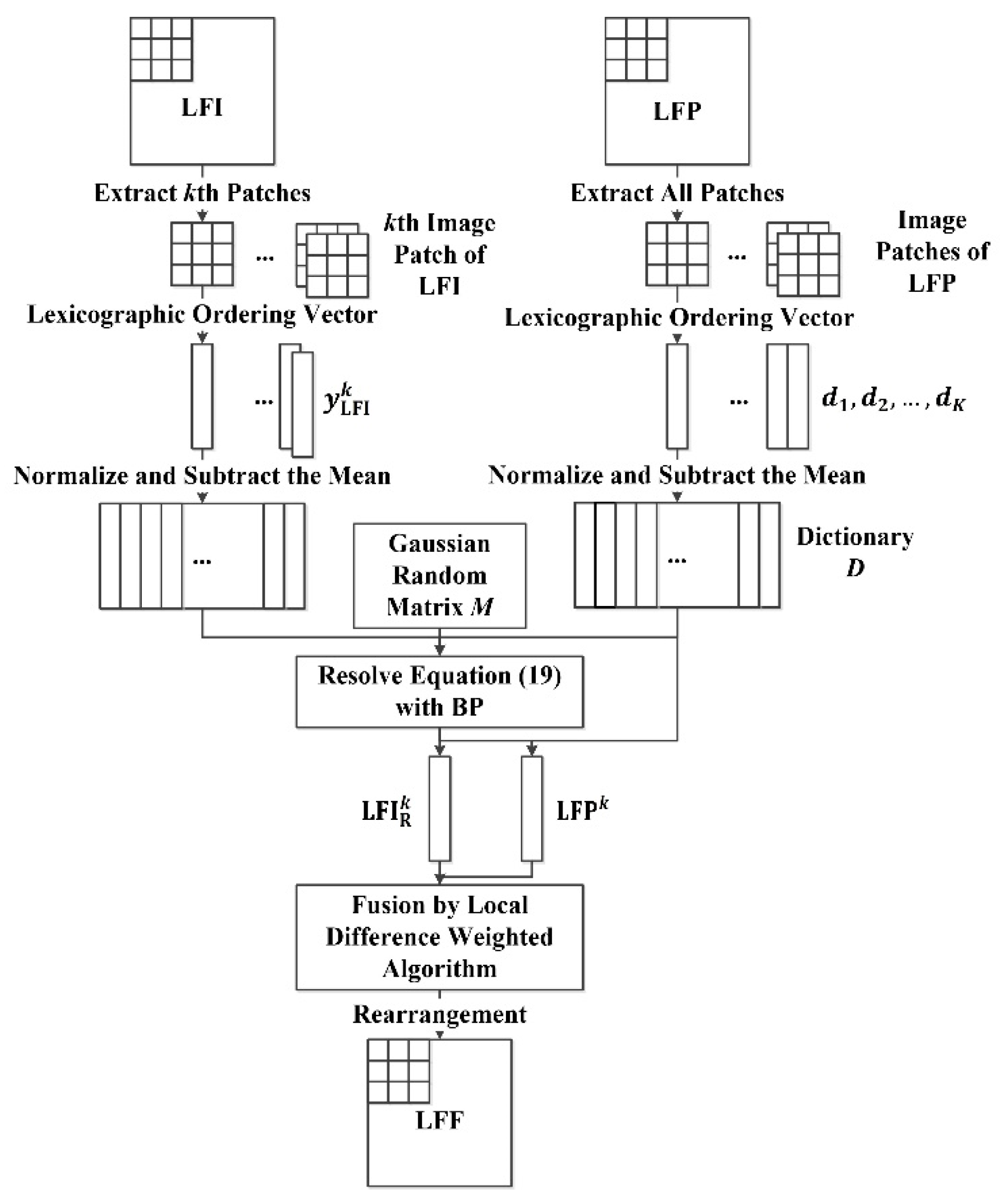

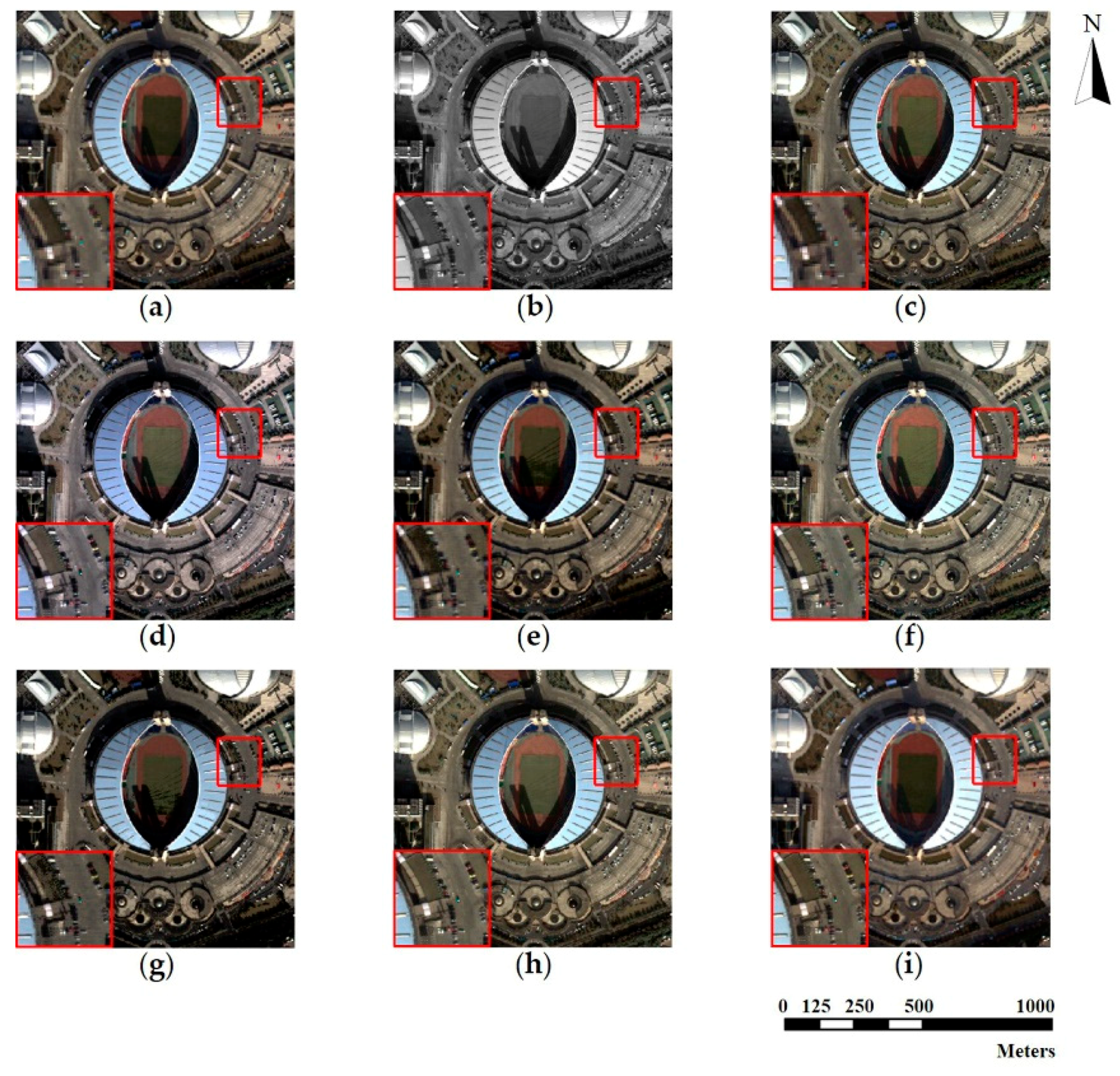

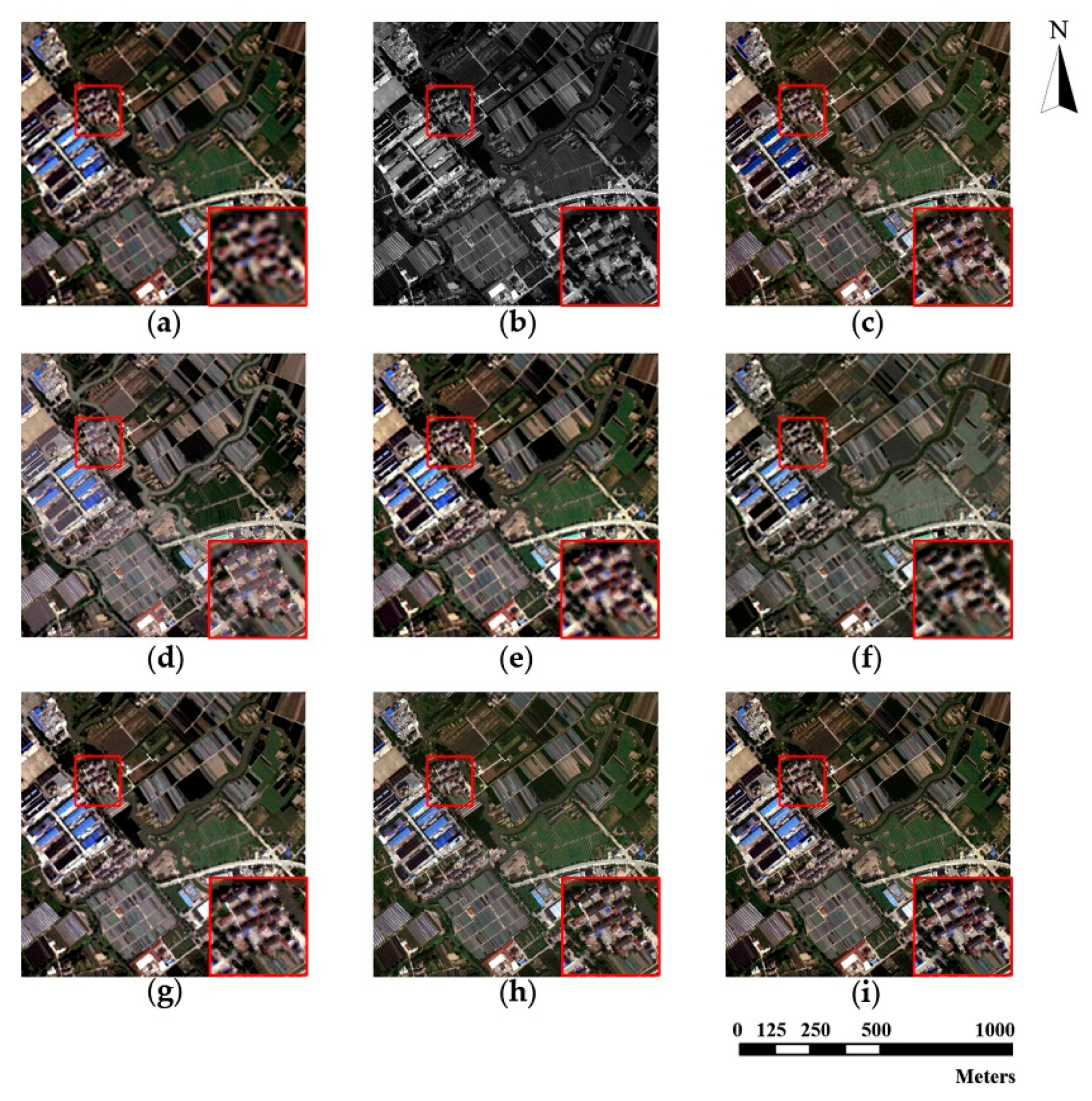

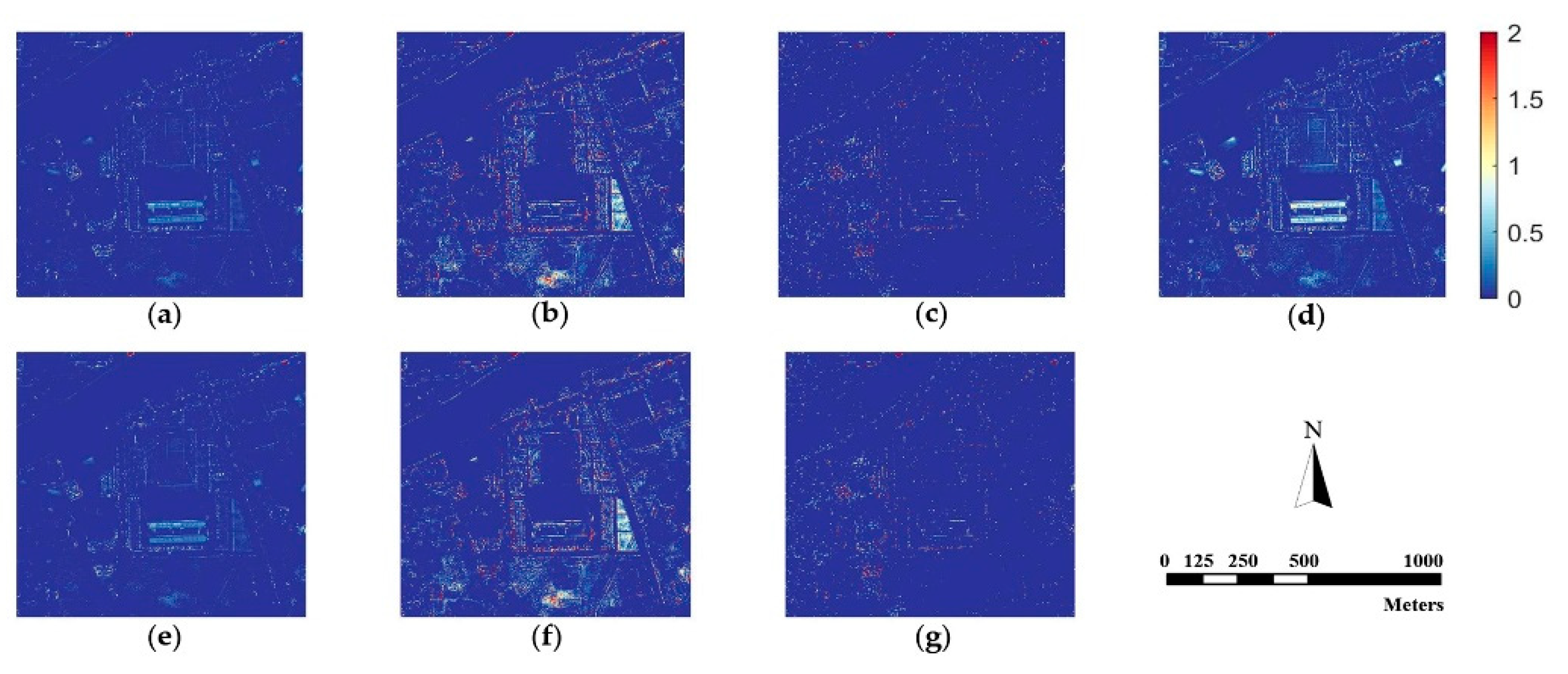
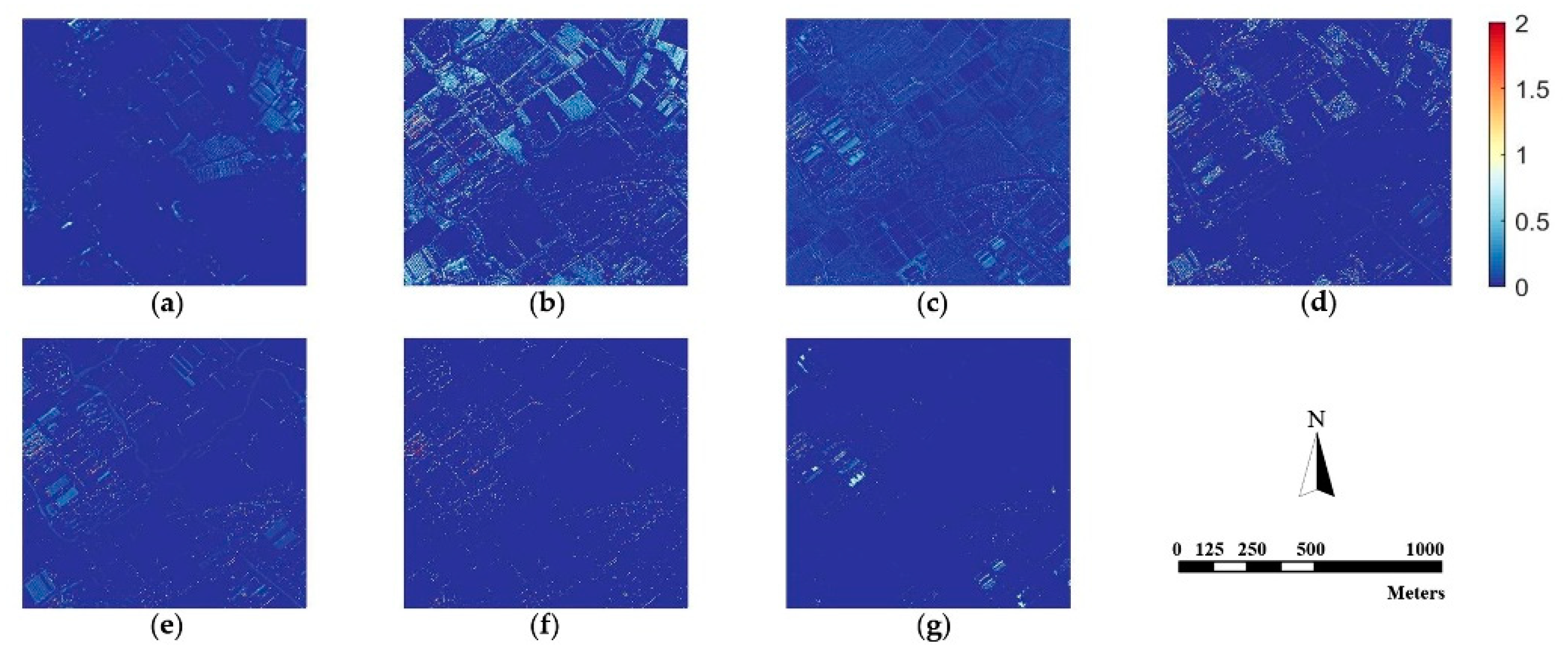
| Features | WorldView-2 | Pleiades-1A | Triplesat | ||||
|---|---|---|---|---|---|---|---|
| PAN | MS | PAN | MS | PAN | MS | ||
| Spatial Resolution | 0.46 m | 1.84 m | 0.5 m | 2 m | 0.8 m | 3.2 m | |
| Spectral Response | 450–800 nm | Costal (C): 400–450 nm | Red (R): 630–690 nm | 470–830 nm | Blue (B): 430–550 nm | 450–650 nm | Blue (B): 440–510 nm |
| Blue (B): 450–510 nm | Red Edge (RE): 705–745 nm | Green (G): 500–620 nm | Green (G): 510–590 nm | ||||
| Green (G): 510–580 nm | Near IR-1 (NIR-1): 770–895 nm | Red (R): 590–710 nm | Red (R): 600–670 nm | ||||
| Yellow (Y): 585–625 nm | Near IR-2 (NIR-2): 860–900 nm | Near IR (NIR): 740–940 nm | Near IR (NIR): 760–910 nm | ||||
| Quantization Value | 11 Bits | 12 Bits or 16 Bits | 10 Bits | ||||
| Imaging Location | Huang Long Stadium in Hangzhou, China | Xuanen county government in Enshi, China | Qingpu district in Shanghai, China | ||||
| Imaging Time | 20 December 2009 | 13 April 2015 | 18 September 2017 | ||||
| Index | GS | Method | ||||||
|---|---|---|---|---|---|---|---|---|
| AIHS | WT-SR | WT-IHS | CT-ICA | CSI | Proposed | |||
| Correlation coefficient (CC) | R | 0.945 | 0.896 | 0.912 | 0.910 | 0.938 | 0.941 | 0.952 |
| G | 0.936 | 0.879 | 0.934 | 0.915 | 0.924 | 0.953 | 0.957 | |
| B | 0.940 | 0.925 | 0.927 | 0.912 | 0.947 | 0.948 | 0.949 | |
| Average | 0.941 | 0.900 | 0.924 | 0.912 | 0.936 | 0.947 | 0.953 | |
| Root mean square error (RMSE) | R | 15.02 | 16.96 | 15.67 | 16.24 | 14.68 | 15.17 | 14.91 |
| G | 14.86 | 16.85 | 15.94 | 16.36 | 14.96 | 13.82 | 13.64 | |
| B | 14.07 | 17.23 | 16.07 | 15.91 | 15.24 | 13.94 | 13.65 | |
| Average | 14.65 | 17.05 | 15.89 | 16.17 | 14.96 | 14.31 | 14.07 | |
| Standard deviation (STD) | R | 63.61 | 59.65 | 58.34 | 63.28 | 62.34 | 66.24 | 65.27 |
| G | 65.09 | 61.23 | 57.97 | 67.95 | 57.68 | 64.16 | 65.33 | |
| B | 62.82 | 57.29 | 58.26 | 61.27 | 58.29 | 63.90 | 65.28 | |
| Average | 63.84 | 59.39 | 58.19 | 64.17 | 59.43 | 64.77 | 65.29 | |
| The relative global synthesis error (ERGAS) | 2.873 | 3.681 | 3.487 | 3.335 | 3.015 | 2.974 | 2.762 | |
| Spectral angle mapper (SAM) | 5.096 | 7.620 | 8.673 | 7.241 | 6.292 | 3.245 | 3.271 | |
| Image quality score index (Q4) | 0.831 | 0.589 | 0.534 | 0.591 | 0.628 | 0.896 | 0.913 | |
| Quality with no reference (QNR) | 0.129 | 0.145 | 0.132 | 0.152 | 0.137 | 0.125 | 0.121 | |
| 0.143 | 0.186 | 0.174 | 0.163 | 0.151 | 0.134 | 0.132 | ||
| Average | 0.808 | 0.669 | 0.781 | 0.748 | 0.795 | 0.818 | 0.854 | |
| Index | GS | Method | ||||||
|---|---|---|---|---|---|---|---|---|
| AIHS | WT-SR | WT-IHS | CT-ICA | CSI | proposed | |||
| CC | R | 0.833 | 0.675 | 0.806 | 0.713 | 0.867 | 0.821 | 0.875 |
| G | 0.802 | 0.623 | 0.814 | 0.756 | 0.859 | 0.834 | 0.861 | |
| B | 0.799 | 0.694 | 0.795 | 0.697 | 0.874 | 0.806 | 0.868 | |
| Average | 0.811 | 0.664 | 0.805 | 0.722 | 0.867 | 0.820 | 0.868 | |
| RMSE | R | 10.14 | 13.68 | 10.29 | 12.40 | 9.799 | 10.28 | 9.014 |
| G | 9.996 | 13.55 | 10.37 | 12.52 | 9.368 | 9.867 | 9.257 | |
| B | 10.11 | 13.27 | 11.15 | 12.70 | 9.257 | 10.02 | 9.119 | |
| Average | 9.773 | 13.50 | 10.60 | 12.54 | 9.475 | 10.05 | 9.130 | |
| STD | R | 53.02 | 56.56 | 47.92 | 51.37 | 52.51 | 55.69 | 55.24 |
| G | 53.97 | 52.46 | 46.58 | 52.17 | 53.11 | 54.72 | 55.67 | |
| B | 54.12 | 53.65 | 47.14 | 52.64 | 52.89 | 55.02 | 55.94 | |
| Average | 53.70 | 54.16 | 47.22 | 52.00 | 52.84 | 55.15 | 55.62 | |
| ERGAS | 1.709 | 2.689 | 2.054 | 2.337 | 1.680 | 1.806 | 1.547 | |
| SAM | 1.643 | 2.081 | 1.854 | 1.922 | 1.725 | 1.734 | 1.549 | |
| Q4 | 0.878 | 0.657 | 0.762 | 0.715 | 0.865 | 0.890 | 0.894 | |
| QNR | 0.119 | 0.264 | 0.181 | 0.254 | 0.213 | 0.157 | 0.119 | |
| 0.102 | 0.118 | 0.097 | 0.154 | 0.105 | 0.094 | 0.086 | ||
| Average | 0.810 | 0.675 | 0.834 | 0.760 | 0.798 | 0.825 | 0.874 | |
| Index | GS | Method | ||||||
|---|---|---|---|---|---|---|---|---|
| AIHS | WT-SR | WT-IHS | CT-ICA | CSI | proposed | |||
| CC | R | 0.905 | 0.757 | 0.852 | 0.884 | 0.939 | 0.961 | 0.975 |
| G | 0.917 | 0.778 | 0.867 | 0.904 | 0.928 | 0.963 | 0.982 | |
| B | 0.893 | 0.802 | 0.840 | 0.898 | 0.922 | 0.975 | 0.966 | |
| Average | 0.905 | 0.779 | 0.853 | 0.895 | 0.930 | 0.966 | 0.974 | |
| RMSE | R | 19.83 | 30.81 | 25.42 | 26.73 | 22.40 | 12.42 | 10.08 |
| G | 16.77 | 29.96 | 24.36 | 28.39 | 22.33 | 12.18 | 9.422 | |
| B | 13.92 | 30.46 | 25.05 | 27.57 | 20.50 | 10.75 | 11.60 | |
| Average | 16.74 | 30.41 | 24.94 | 27.56 | 21.74 | 11.78 | 10.37 | |
| STD | R | 59.80 | 60.06 | 47.56 | 57.01 | 51.66 | 62.17 | 63.52 |
| G | 61.07 | 60.61 | 48.73 | 57.79 | 51.86 | 62.62 | 62.07 | |
| B | 60.58 | 59.59 | 47.34 | 56.50 | 50.14 | 62.37 | 62.17 | |
| Average | 60.48 | 60.09 | 47.88 | 57.10 | 51.13 | 62.39 | 62.59 | |
| ERGAS | 1.402 | 3.925 | 1.875 | 2.613 | 1.534 | 1.394 | 1.360 | |
| SAM | 1.996 | 5.341 | 3.522 | 4.898 | 2.847 | 2.002 | 1.987 | |
| Q4 | 0.810 | 0.675 | 0.806 | 0.761 | 0.861 | 0.925 | 0.979 | |
| QNR | 0.177 | 0.329 | 0.168 | 0.214 | 0.175 | 0.137 | 0.149 | |
| 0.138 | 0.205 | 0.177 | 0.198 | 0.154 | 0.116 | 0.103 | ||
| Average | 0.810 | 0.668 | 0.715 | 0.694 | 0.767 | 0.832 | 0.869 | |
| Dataset | CC | Kernel Size | |||||
|---|---|---|---|---|---|---|---|
| 3 × 3 | 5 × 5 | 7 × 7 | 9 × 9 | 11 × 11 | 13 × 13 | ||
| WorldView-2 | PS and PAN | 0.738 | 0.765 | 0.776 | 0.797 | 0.831 | 0.841 |
| PS and MS | 0.969 | 0.958 | 0.935 | 0.902 | 0.881 | 0.867 | |
| Sum | 1.707 | 1.723 | 1.721 | 1.699 | 1.712 | 1.708 | |
| Pleiades | PS and PAN | 0.715 | 0.731 | 0.742 | 0.757 | 0.772 | 0.791 |
| PS and MS | 0.879 | 0.868 | 0.847 | 0.833 | 0.825 | 0.802 | |
| Sum | 1.594 | 1.599 | 1.589 | 1.590 | 1.577 | 1.593 | |
| Triplesat | PS and PAN | 0.732 | 0.788 | 0.805 | 0.835 | 0.842 | 0.846 |
| PS and MS | 0.981 | 0.974 | 0.955 | 0.921 | 0.913 | 0.902 | |
| Sum | 1.713 | 1.762 | 1.760 | 1.756 | 1.755 | 1.746 | |
| Image Patch Size | Overlapping Ratio | CC (Avg) | RMSE (Avg) | STD (Avg) | ERGAS | SAM | Q4 | QNR (Avg) | Time (s) |
|---|---|---|---|---|---|---|---|---|---|
| 5 × 5 | 5% | 0.887 | 19.02 | 55.21 | 3.330 | 4.315 | 0.804 | 0.751 | 40.91 |
| 5 × 5 | 10% | 0.906 | 18.27 | 57.93 | 3.205 | 4.298 | 0.827 | 0.766 | 56.43 |
| 5 × 5 | 15% | 0.921 | 17.49 | 59.66 | 3.119 | 4.102 | 0.840 | 0.794 | 82.72 |
| 5 × 5 | 20% | 0.934 | 17.33 | 60.57 | 3.012 | 3.926 | 0.856 | 0.801 | 107.5 |
| 7 × 7 | 5% | 0.949 | 16.21 | 63.01 | 2.887 | 3.614 | 0.891 | 0.835 | 61.25 |
| 7 × 7 | 10% | 0.951 | 14.95 | 64.67 | 2.824 | 3.359 | 0.907 | 0.847 | 85.60 |
| 7 × 7 | 15% | 0.953 | 14.07 | 65.29 | 2.762 | 3.271 | 0.913 | 0.854 | 119.7 |
| 7 × 7 | 20% | 0.954 | 13.65 | 65.33 | 2.637 | 3.153 | 0.918 | 0.862 | 162.1 |
| 9 × 9 | 5% | 0.924 | 14.73 | 63.29 | 2.835 | 3.825 | 0.882 | 0.826 | 72.71 |
| 9 × 9 | 10% | 0.930 | 14.65 | 63.37 | 2.829 | 3.814 | 0.897 | 0.833 | 105.8 |
| 9 × 9 | 15% | 0.935 | 14.58 | 63.45 | 2.820 | 3.802 | 0.903 | 0.839 | 156.1 |
| 9 × 9 | 20% | 0.937 | 14.46 | 63.58 | 2.813 | 3.796 | 0.909 | 0.841 | 182.9 |
| 11 × 11 | 5% | 0.918 | 15.32 | 62.09 | 2.964 | 3.967 | 0.873 | 0.811 | 86.50 |
| 11 × 11 | 10% | 0.924 | 15.24 | 62.17 | 2.947 | 3.956 | 0.879 | 0.817 | 117.1 |
| 11 × 11 | 15% | 0.931 | 15.13 | 62.22 | 2.939 | 3.943 | 0.885 | 0.824 | 165.6 |
| 11 × 11 | 20% | 0.935 | 15.09 | 62.36 | 2.932 | 3.937 | 0.891 | 0.829 | 196.4 |
| Image Patch Size | Overlapping Ratio | CC (Avg) | RMSE (Avg) | STD (Avg) | ERGAS | SAM | Q4 | QNR (Avg) | Time (s) |
|---|---|---|---|---|---|---|---|---|---|
| 5 × 5 | 5% | 0.788 | 10.267 | 44.328 | 2.339 | 2.357 | 0.786 | 0.781 | 24.26 |
| 5 × 5 | 10% | 0.795 | 9.901 | 46.583 | 2.328 | 2.340 | 0.801 | 0.793 | 59.67 |
| 5 × 5 | 15% | 0.813 | 9.825 | 48.772 | 2.224 | 2.214 | 0.815 | 0.805 | 80.41 |
| 5 × 5 | 20% | 0.821 | 9.658 | 49.935 | 2.107 | 2.098 | 0.834 | 0.829 | 95.93 |
| 7 × 7 | 5% | 0.837 | 9.246 | 53.839 | 1.715 | 1.772 | 0.863 | 0.847 | 49.47 |
| 7 × 7 | 10% | 0.854 | 9.224 | 54.348 | 1.606 | 1.618 | 0.879 | 0.861 | 80.65 |
| 7 × 7 | 15% | 0.868 | 9.130 | 55.617 | 1.547 | 1.549 | 0.894 | 0.874 | 124.3 |
| 7 × 7 | 20% | 0.882 | 9.067 | 56.811 | 1.435 | 1.421 | 0.912 | 0.886 | 165.7 |
| 9 × 9 | 5% | 0.811 | 9.425 | 51.267 | 1.809 | 1.795 | 0.851 | 0.835 | 50.66 |
| 9 × 9 | 10% | 0.820 | 9.319 | 51.983 | 1.775 | 1.682 | 0.860 | 0.842 | 61.42 |
| 9 × 9 | 15% | 0.829 | 9.221 | 52.617 | 1.661 | 1.607 | 0.873 | 0.856 | 98.71 |
| 9 × 9 | 20% | 0.836 | 9.178 | 53.209 | 1.587 | 1.534 | 0.889 | 0.868 | 174.9 |
| 11 × 11 | 5% | 0.805 | 9.729 | 50.664 | 1.924 | 1.895 | 0.847 | 0.822 | 72.83 |
| 11 × 11 | 10% | 0.814 | 9.633 | 51.709 | 1.873 | 1.862 | 0.851 | 0.829 | 103.6 |
| 11 × 11 | 15% | 0.827 | 9.521 | 53.105 | 1.705 | 1.734 | 0.864 | 0.838 | 138.7 |
| 11 × 11 | 20% | 0.833 | 9.413 | 54.018 | 1.582 | 1.607 | 0.877 | 0.845 | 190.1 |
| Image Patch Size | Overlapping Ratio | CC (Avg) | RMSE (Avg) | STD (Avg) | ERGAS | SAM | Q4 | QNR (Avg) | Time (s) |
|---|---|---|---|---|---|---|---|---|---|
| 5 × 5 | 5% | 0.883 | 11.304 | 51.178 | 2.016 | 3.357 | 0.917 | 0.798 | 35.34 |
| 5 × 5 | 10% | 0.898 | 11.295 | 52.591 | 1.912 | 3.102 | 0.921 | 0.803 | 62.40 |
| 5 × 5 | 15% | 0.907 | 11.187 | 53.834 | 1.887 | 2.945 | 0.925 | 0.811 | 105.4 |
| 5 × 5 | 20% | 0.924 | 11.062 | 54.367 | 1.654 | 2.798 | 0.934 | 0.826 | 162.7 |
| 7 × 7 | 5% | 0.951 | 10.563 | 60.498 | 1.456 | 2.223 | 0.955 | 0.847 | 84.64 |
| 7 × 7 | 10% | 0.962 | 10.445 | 62.067 | 1.398 | 2.148 | 0.968 | 0.853 | 125.3 |
| 7 × 7 | 15% | 0.974 | 10.368 | 62.586 | 1.360 | 1.987 | 0.979 | 0.869 | 141.5 |
| 7 × 7 | 20% | 0.989 | 10.017 | 63.054 | 1.349 | 1.905 | 0.982 | 0.874 | 188.4 |
| 9 × 9 | 5% | 0.941 | 10.664 | 55.392 | 1.489 | 2.482 | 0.940 | 0.841 | 94.51 |
| 9 × 9 | 10% | 0.952 | 10.532 | 56.018 | 1.447 | 2.405 | 0.954 | 0.849 | 110.9 |
| 9 × 9 | 15% | 0.966 | 10.467 | 56.981 | 1.394 | 2.349 | 0.963 | 0.855 | 145.2 |
| 9 × 9 | 20% | 0.975 | 10.395 | 57.765 | 1.251 | 2.297 | 0.977 | 0.863 | 191.6 |
| 11 × 11 | 5% | 0.933 | 10.894 | 56.215 | 1.664 | 2.664 | 0.933 | 0.832 | 86.32 |
| 11 × 11 | 10% | 0.941 | 10.752 | 57.541 | 1.598 | 2.615 | 0.941 | 0.839 | 119.7 |
| 11 × 11 | 15% | 0.957 | 10.663 | 58.165 | 1.435 | 2.533 | 0.956 | 0.847 | 158.5 |
| 11 × 11 | 20% | 0.969- | 10.597 | 59.085 | 1.357 | 2.498 | 0.968 | 0.851 | 200.2 |
© 2018 by the authors. Licensee MDPI, Basel, Switzerland. This article is an open access article distributed under the terms and conditions of the Creative Commons Attribution (CC BY) license (http://creativecommons.org/licenses/by/4.0/).
Share and Cite
Yang, C.; Zhan, Q.; Liu, H.; Ma, R. An IHS-Based Pan-Sharpening Method for Spectral Fidelity Improvement Using Ripplet Transform and Compressed Sensing. Sensors 2018, 18, 3624. https://doi.org/10.3390/s18113624
Yang C, Zhan Q, Liu H, Ma R. An IHS-Based Pan-Sharpening Method for Spectral Fidelity Improvement Using Ripplet Transform and Compressed Sensing. Sensors. 2018; 18(11):3624. https://doi.org/10.3390/s18113624
Chicago/Turabian StyleYang, Chen, Qingming Zhan, Huimin Liu, and Ruiqi Ma. 2018. "An IHS-Based Pan-Sharpening Method for Spectral Fidelity Improvement Using Ripplet Transform and Compressed Sensing" Sensors 18, no. 11: 3624. https://doi.org/10.3390/s18113624
APA StyleYang, C., Zhan, Q., Liu, H., & Ma, R. (2018). An IHS-Based Pan-Sharpening Method for Spectral Fidelity Improvement Using Ripplet Transform and Compressed Sensing. Sensors, 18(11), 3624. https://doi.org/10.3390/s18113624






